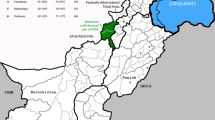Abstract
Genetic diversity is an area of concern for sustaining crop yield. Information on genetic relatedness/diversity among Gossypium arboreum L. cultivars/genotypes is scanty. We have used random amplified polymorphic DNA (RAPD) analysis to assess the genetic divergence/relationship among 30 genotypes/cultivars of G. arboreum. Of 45 primers surveyed, 63% were polymorphic. Out of the total number of loci amplified, 36% were polymorphic. The calculated genetic similarity between the cultivars/genotypes was in the range of 47.05–98.73%. Two genotypes, HK-244 and Entry-17, were the most distantly related. The average genetic relatedness among all the genotypes was 80.46%. However, most of the cultivated varieties showed a close genetic relationship, indicating a narrow genetic base in comparison to the non-cultivated germplasm. The calculated coefficients were used to construct a dendrogram using the unweighted pair group of arithmetic means (UPGMA) algorithm, which grouped the genotypes/cultivars into two major and three smaller clusters. The study is the first comprehensive analysis of the genetic diversity of G. arboreum germplasm and identifies cultivars that will be useful in extending the genetic diversity of cultivated varieties and future genome mapping projects.



Similar content being viewed by others
References
Arpat AB, Waugh M, Sullivan JP, Gonzales M, Frisch D, Main D, Wood T, Leslie A, Wing RA, Wilkins TA (2004) Functional genomics of cell elongation in developing cotton fibers. Plant Mol Biol 54:911–929
Beasley JO (1940) The production of polyploids in Gossypium. J Hered 31:39–48
Bligh HFJ, Blackhall NM, Edwards KJ, McClung AM (1999) Using amplified fragment length polymorphisms and simple sequence length polymorphisms to identify cultivars of brown and white milled rice. Crop Sci 39:1715–1721
Clerc VL, Bazante F, Baril C, Guiard J, Zhang D (2004) Assessing temporal changes in genetic diversity of maize varieties using microsatellite markers. Theor Appl Genet 90:124–139
Endrizzi J, Turcotte EL, Kohel RJ (1985) Genetics, cytology, and evolution of Gossypium. Adv Genet 23:272–375
Fernández ME, Figueiras AM, Benito C (2002) The use of ISSR and RAPD markers for detecting DNA polymorphism, genotype identification and genetic diversity among barley cultivars with known origin. Theor Appl Genet 104:845–851
Fryxell PA (1992) A revised taxonomic interpretation of Gossypium L. (Malvaceae). Rheedea 2:108–165
Iqbal MJ, Aziz N, Saeed NA, Zafar Y, Malik KA (1997) Genetic diversity of some elite cotton varieties by RAPD analysis. Theor Appl Genet 94:139–144
Iqbal MJ, OUK Reddy KM El-Zik AE Pepper (2001) A genetic bottle neck in the evolution under domestication of upland cotton Gossypium hirsutum L. examined using DNA fingerprinting. Theor Appl Genet 103:547–554
Moulherat C, Tengberg M, Haquet JF, Mille B (2002) First evidence of cotton at neolithic Mehrgarh, Pakistan: analysis of mineralized fibres from a copper bead. J Archaeol Sci 29:1393–1401
Nei N, Li W (1979) Mathematical model for studying genetic variation in terms of restriction endonuclease. Proc Natl Acad Sci USA 76:5269–5273
Olufowote JO, Xu Y, Chen X, Park WD, Beachell HM, Dilday RH, Goto M, McCouch SR (1997) Comparative evaluation of within-cultivar variation of rice (Oryza sativa L.) using microsatellite and RFLP markers. Genome 40:370–378
Pillay M, Meyers GO (1999) Genetic diversity in cotton assessed by variation in ribosomal RNA genes and AFLP markers. Crop Sci 39:1881–1886
Rahman M, Hussain D, Zafar Y (2002) Estimation of genetic divergence among elite cotton (Gossypium hirsutum L.) cultivars/genotypes by DNA fingerprinting technology. Crop Sci 42:2137–2144
Rahman M, Malik TA, Hussain D, Zafar Y (2005) Inheritance of host plant resistant mechanism against cotton leaf curl virus disease (CLCD) in cotton. Plant Pathology 54:764–772
Rahman M., Yasmin T., Shaheen HL, Shaheen T, Tabassam N, Zafar Y (2006) Harvesting genetic diversity in the cotton genome. National symposium on biotechnology for economic prosperity organized by National Commission on Biotechnology, Green Retreat Hotel, Nathiagali, Pakistan, July 24–26, (2006) pp 38
Rana MK, Bhat KV (2004) A comparison of AFLP and RAPD markers for genetic diversity and cultivar identification in cotton. J Plant Biochem Biotech 13:19–24
Sneath P, Sokal R (1973) Numerical taxonomy. Freeman, San Francisco
Stewart JM (1994) Potential for crop improvement with exotic germplasm and genetic engineering. Challenging the future: Proceedings of the World Cotton Research Conference-1, Brisbane Australia, GA Constable and NW Forrester (eds) CSIRO, Melbourne, Australia, pp 313–327
Vafaie-Tabar M, Chandrashekaran S, Rana MK, Bhat KV (2004) RAPD analysis of genetic diversity in Indian tetraploid and diploid cotton (Gossypium spp.). J Plant Biochem Biotech 13:81–84
Villarreal DZ, GarciaMarin PC, de la Cruz EP, Delgado-Valerio P, Gepts P (2005) Population structure and evolutionary dynamics of wild–weedy–domesticated complexes of common bean in a mesoamerican region. Crop Sci 45:1073–1083
Virk PS, Newbury HJ, Jackson MT, Fordlloyd BV (1995) The identification of duplicate accessions within a rice germplasm collection using RAPD analysis. Theor Appl Genet 90:1049–1055
Wendel JF, Olson PD, Stewart JM (1989) Genetic diversity, introgression and independents domestication of old world cultivated cottons. Am J Bot 76:1795–1806
Zhu Y, Chen H, Fan J, Wang Y, Li Y, Chen J, Fan J, Yang S, Hu L, Leung H, Mew TW, Teng PS, Wang Z, Mundt CC (2000) Genetic diversity and disease control in rice. Nature 406:718–722
Acknowledgement
We thank the Pakistan Agriculture Research Council (PARC), Islamabad, Pakistan for financial support under the ALP programme. We are also thankful to the Director cotton CRI Faisalabad for providing us the cottonseed of G arboreum genotypes. We are grateful to Prof. Dr. Rob W. Briddon (employed at NIBGE under the Higher Education Commission [Pakistan] ‘‘Foreign Faculty Hiring’’ scheme) for critical reading of the manuscript and Peter Long (University of Bath) for his help in compiling the map of Pakistan.
Author information
Authors and Affiliations
Corresponding author
Rights and permissions
About this article
Cite this article
Mehboob-ur-Rahman, Yasmin, T., Tabbasam, N. et al. Studying the extent of genetic diversity among Gossypium arboreum L. genotypes/cultivars using DNA fingerprinting. Genet Resour Crop Evol 55, 331–339 (2008). https://doi.org/10.1007/s10722-007-9238-1
Received:
Accepted:
Published:
Issue Date:
DOI: https://doi.org/10.1007/s10722-007-9238-1




